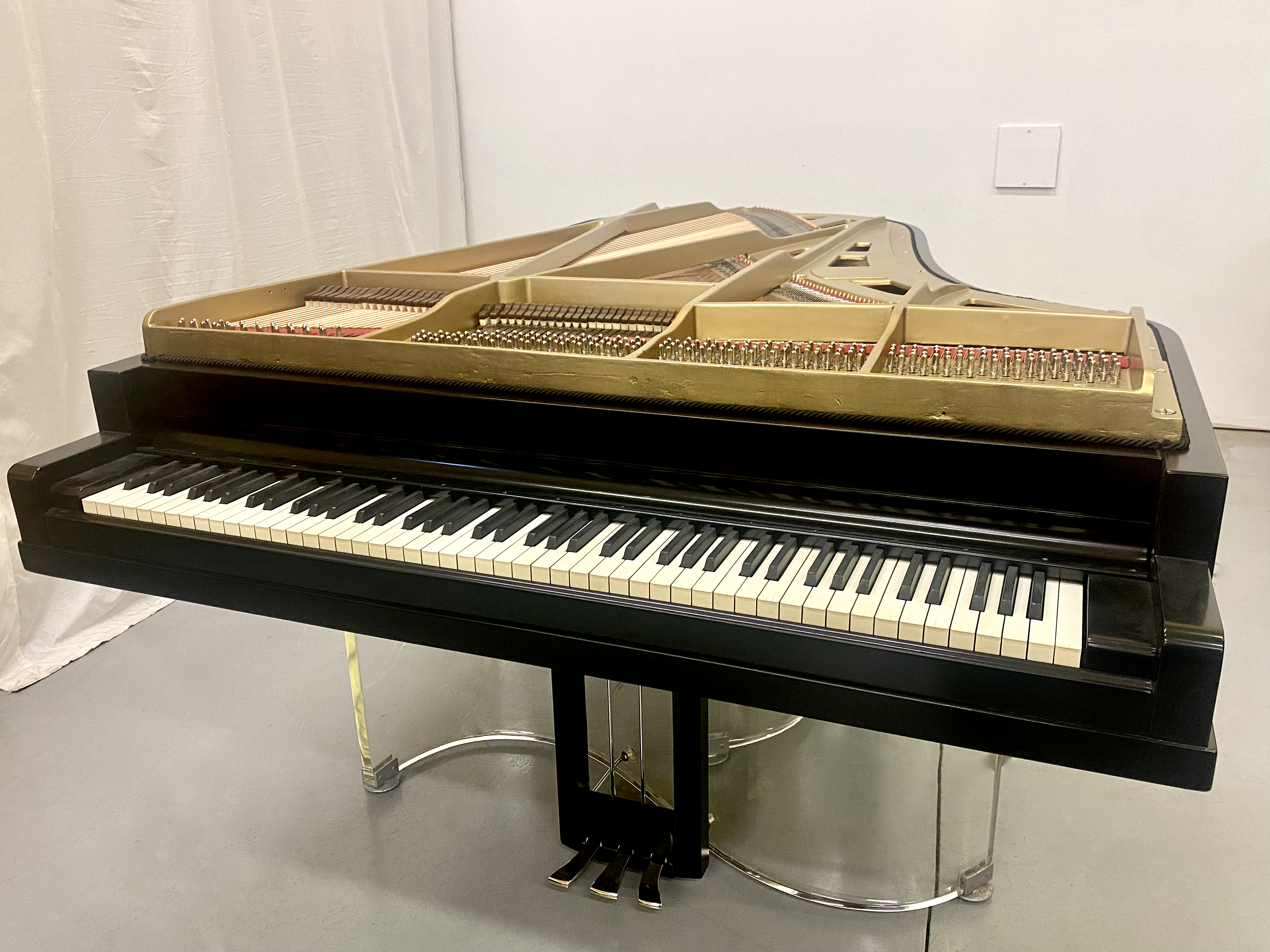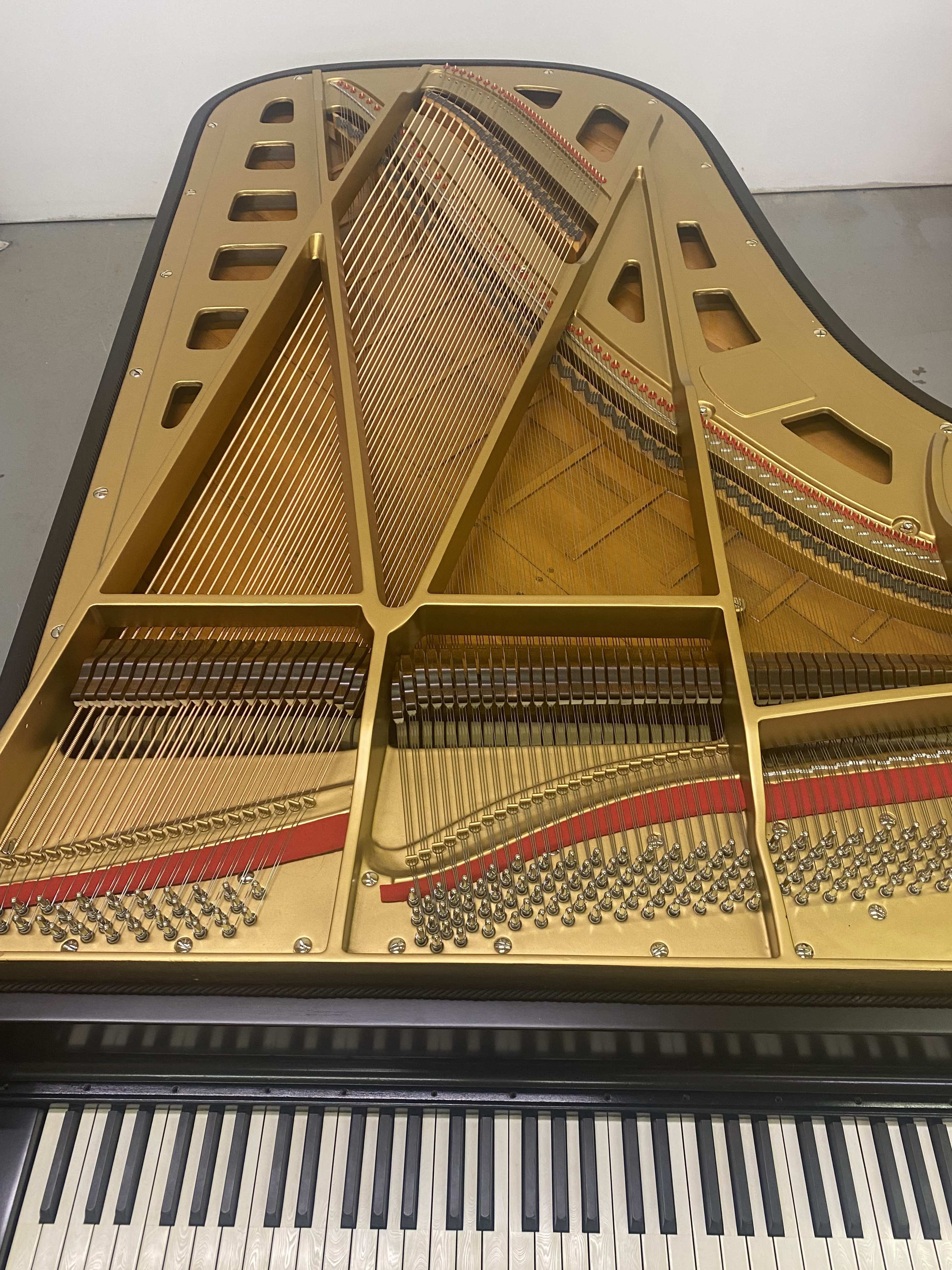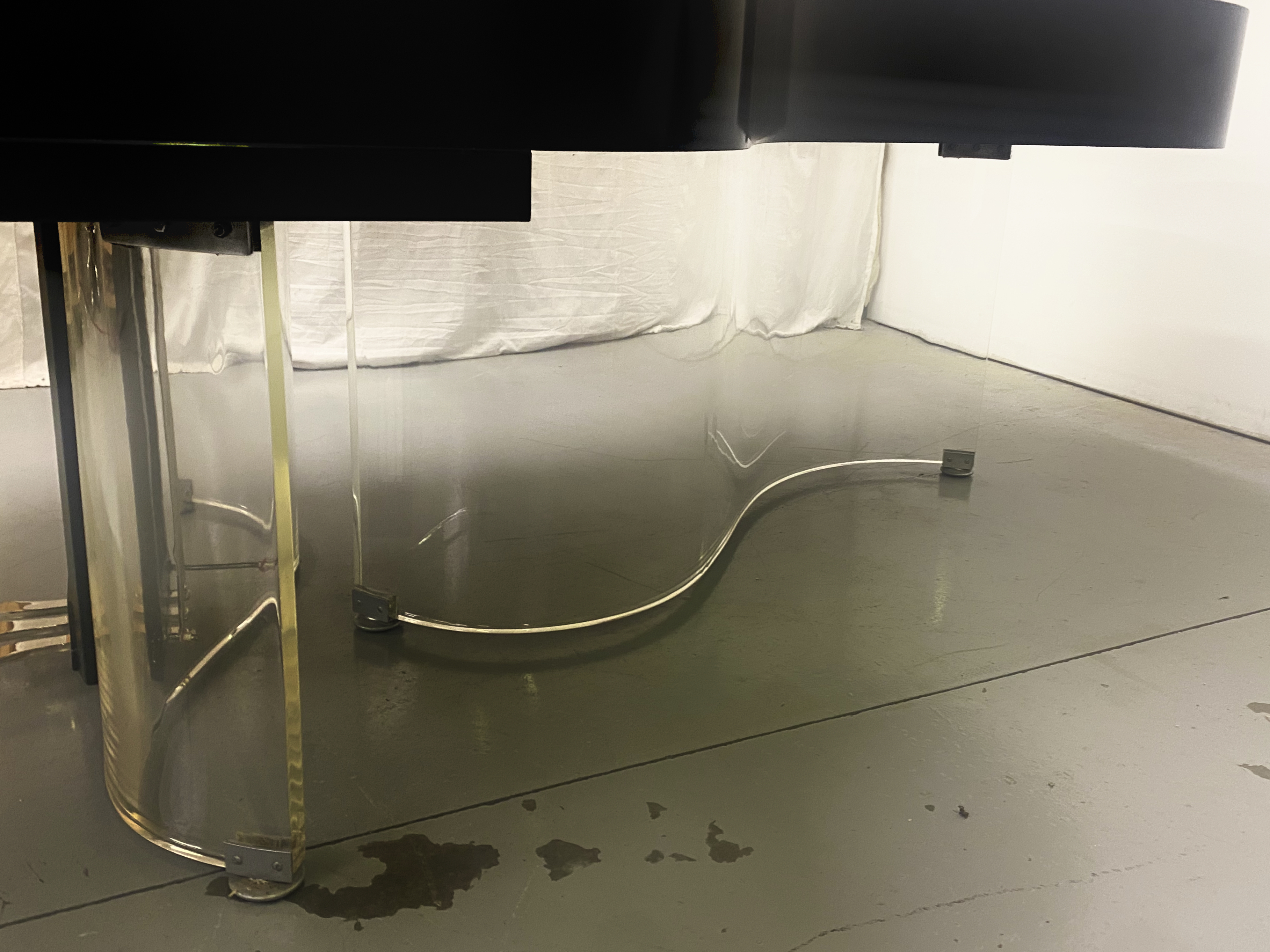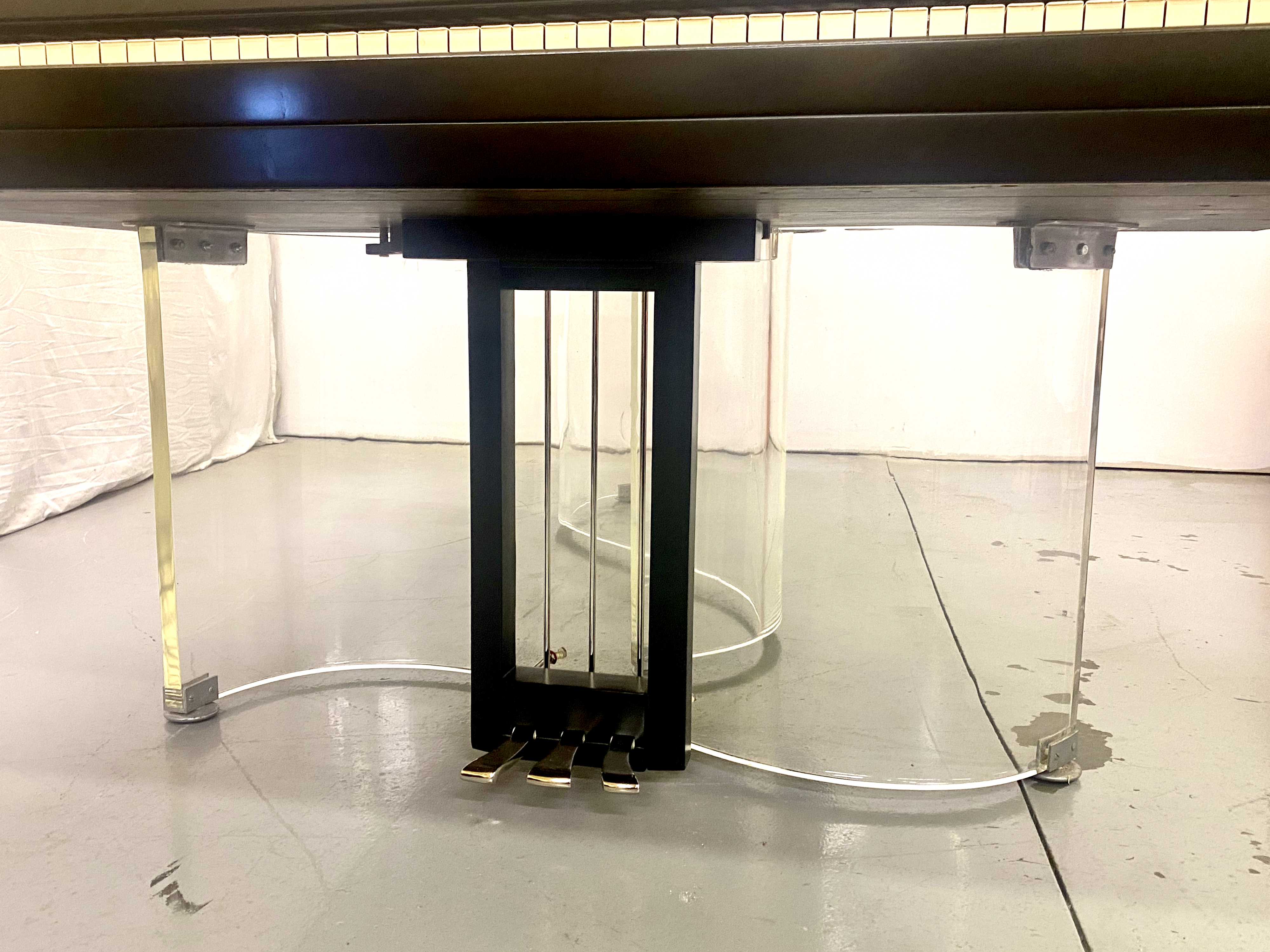Rare 1940 Wurlitzer Model 770 Art Deco Grand Piano
About This Wurlitzer Piano
Museum-worthy Rarity: 1940 Wurlitzer Model 770 Grand Piano
A masterpiece of mid-century engineering and artistry, this extraordinary Wurlitzer Model 770 grand piano stands as one of only two known examples in existence. Introduced in 1940 at a Chicago exhibition during America's economic recovery from the Great Depression, this art-deco-inspired instrument represents both a technical milestone for Wurlitzer and a bold aesthetic statement in piano manufacturing. Trade publications from the era described it as a "technological marvel," emphasizing its innovative design that challenged traditional piano architecture with its groundbreaking exposed string configuration and sculptural elements that epitomize the progressive spirit of American industrial prowess.
Modernist Marvel: Plexiglass Artistry
The Model 770 showcases Wurlitzer's avant-garde approach with stunning Plexiglass arabesques that create a striking visual profile. Unlike traditional grand pianos with ornate wooden casings, this instrument exemplifies the art-deco movement's emphasis on streamlined forms and industrial materials.
Meticulous Restoration
The cabinet has been tastefully refinished in black satin. This creates a more contemporary visual appeal that works seamlessly in modern interior settings while providing an elegant contrast to the translucent Plexiglass elements. For the discerning collector, this piano represents the perfect marriage of historical authenticity and contemporary elegance.
Transparent Beauty: The Lidless Wonder
The piano's most striking feature—its lidless design with elevated strings and plate—transforms the traditional grand piano into a captivating piece of functional art. This architectural innovation allows viewers to witness the intricate mechanics of music-making, creating a mesmerizing focal point for any curated space. The sole other example of this visionary design resides in the permanent collection of the Schubert Club in Saint Paul, Minnesota.
Exceptional Preservation & Authentic Sound
The original ivory and ebony keys remain remarkably intact for their age—a testament to the piano's careful stewardship through the decades. Though showing subtle signs of their historical journey, their condition is exceptional for an instrument of this era. The handcrafted German Heller bass strings deliver the warm, rich tonality that sophisticated audiophiles covet, while the seven-foot scale design provides the commanding presence and depth of sound that defines superior grand pianos.
Original Voice, Modern Reliability
This exceptional instrument has recently undergone a meticulous restoration by master craftsmen, ensuring it remains both a stunning visual statement and a functional instrument. The mechanical components have been precisely adjusted and tuned to maintain their integrity for future generations. The action and hammers remain original, preserving the authentic vintage voice of 1940—a sound that cannot be replicated by modern manufacturing techniques.
An Unrepeatable Opportunity
This Wurlitzer represents a singular opportunity to acquire an important piece of American musical innovation—where modernist design philosophy meets exceptional acoustic engineering in a form that will never be reproduced. A sound investment in musical history for the discerning collector.
Technical Specifications
- Model: Wurlitzer Model 770
- Type: Grand Piano
- Size: 7'4" (224cm)
- Year: 1940
- Finish: Satin Black with Transparent Plexiglass Base
- Serial Number: 207657
- Keyboard: 88 keys
- Pedals: 3 (Sustain, Sostenuto, Una Corda)
Frequently Asked Questions About Wurlitzer Pianos
What makes the Wurlitzer Model 770 a rare piano?
The Wurlitzer Model 770 is considered extremely rare because only two examples are known to exist worldwide. Produced in 1940, this art deco piano features revolutionary design elements including transparent Plexiglass components and a unique lidless construction that exposes the strings and plate. Its innovative approach to piano design makes it both a musical instrument and a piece of American art history. The only other known example is in the permanent collection of the Schubert Club museum.
Why is the Wurlitzer 770 considered an art deco piano?
The Wurlitzer 770 embodies art deco design principles through its streamlined form, innovative use of materials, and modernist aesthetic. Created during the late art deco period (1940), it features dramatic Plexiglass arabesques, geometric elements, and the bold combination of traditional and industrial materials that characterized the movement. The piano's emphasis on exposed mechanical elements celebrates the machine age ethos central to art deco design. Its visual drama and futuristic approach made it a statement piece that challenged conventional piano aesthetics.
What is the history of Wurlitzer pianos?
Wurlitzer has a rich history dating back to 1856 when Rudolph Wurlitzer founded the company in Cincinnati, Ohio. Though initially importing musical instruments from Germany, Wurlitzer began manufacturing pianos in the early 1900s. The company became renowned for both traditional pianos and innovative designs, including electric pianos in the mid-20th century that revolutionized popular music. Wurlitzer pianos have been featured in countless recordings across jazz, rock, and pop music. The company's experimental designs, like the Model 770, represent Wurlitzer's commitment to pushing boundaries in musical instrument design and technology.
How does the value of rare pianos like the Wurlitzer 770 compare to other collectible instruments?
Extremely rare pianos like the Wurlitzer Model 770 occupy a unique position in the collectible instrument market. Their value is determined by multiple factors: historical significance, rarity, design innovation, condition, and provenance. Museum-worthy pianos with documented historical importance can command prices comparable to fine art investments. With only two known examples of the Wurlitzer 770 in existence, this piano represents an unrepeatable acquisition opportunity for serious collectors. Unlike mass-produced instruments, these cultural artifacts typically appreciate in value over time while offering both aesthetic enjoyment and historical significance to their owners.
What should collectors know about maintaining an art deco piano like the Wurlitzer 770?
Maintaining a rare art deco piano like the Wurlitzer 770 requires specialized knowledge and care. The combination of traditional piano components with unique materials like Plexiglass demands a preservation approach that balances musical functionality with artifact conservation. Collectors should maintain stable humidity levels (45-55%) and temperature (68-72°F), position the instrument away from direct sunlight to prevent Plexiglass degradation, and schedule regular maintenance with technicians experienced in vintage instruments. The transparent elements should be cleaned with specialized acrylic-safe products. Professional appraisal documentation should be maintained, and any restoration work should prioritize preserving original materials wherever possible.




